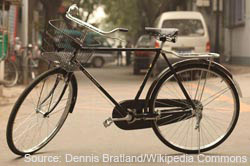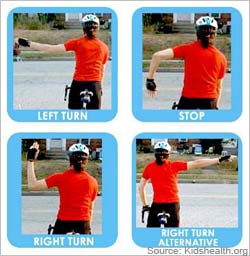Biking is an excellent way to get or stay in shape, and it's also a favorite pastime for many people. Although biking isn't inherently dangerous, learning a few bike safety tips will help keep it a fun sport and activity for you, your kids and friends.

Protective Gear
You should always wear appropriate protective gear when participating in any sport or activity where injuries can occur; riding a bike is no different even if it is only down the street.
As the saying goes, "Use your head, wear a helmet." Helmets are the first and foremost bike safety tip. Find one that fits properly on your head. Bicycling magazines have reported that wearing a properly fitted helmet could prevent 85 percent of cyclists' head injuries.
Keep these things in mind when you're shopping for your new helmet:
- Check the box: Labels that read "bicycle helmet" have to meet the standards of the Consumer Product Safety Commission which is a law in the United States. So when you're shopping around, don't think that a less-expensive helmet won't do the job as well as a higher-priced model. Look for a CPSC sticker on the inside of the helmet for reassurance.
- Construction: Most helmets manufactured today are made of expanded polystyrene foam covered with a tough-but-thin plastic shell. On impact, the foam gets damaged instead of your head. Cheaper helmets are made by gluing or taping the plastic shell on top of the foam while more expensive helmets are molded together when they're made. But don't fret; both helmets are made to withstand impacts.
FYI: After bad impacts or crashes you'll need to replace your helmet. The foam can't be crushed more than once.
- Sizing: Lower-end bike helmets are often one-size-fits all. Generally you need to adjust a strap to keep the helmet fitting snug. Higher-end bike helmets can come in a range of sizes.
TIP: To measure your head, wrap a tape measure around your head just above your ears. Make sure the tape is level, crossing your forehead about an inch above your eyebrows. Then choose a helmet size to match the measurement.
Measuring is no substitute for trying it on. Go to the store and make sure to buy one that fits properly. If you're unsure if your helmet fits properly, take it to the bike store and ask an employee.
What to Wear
When riding, you don't have to wear specialized clothes to stay safe. The main idea is to make sure that your clothing won't hinder or interfere with your riding.
- If your bike doesn't have a chain guard, keep loose pant legs away from the chain by rolling them up.
- Tight and close-fitting clothing will help prevent your skin from chaffing.
- If biking during cold weather, wear layers including gloves and ear warmers. Keep as much skin covered as possible to prevent wind burn and frostbite.
- In the rain, wear bright colors and reflective gear along with waterproof jacket and pants.
- Wear bright and reflective clothing during night bike rides.
Safety while Riding
If you plan on riding in places other than your neighborhood, you'll need to know how to signal cars and other cyclists properly. But first you should know the basics about sharing the road with cars.
- Ride with traffic - not against it.
- Yield to traffic and pedestrians.
- Stop at stop signs and red lights.
- Stay as close to the right as possible except when passing.
- Be predictable. Travel in a straight line unless you're avoiding hazards or passing.

FYI: In the eyes of the law, if you are riding a bicycle on the road, you are considered a vehicle. If you dismount and walk alongside your bicycle, you are considered a pedestrian.
Remember these hand signals to use while riding:
- Turning Left: Extend your left arm straight out to the side
- Turning Right: Extend your left arm to the side and hold your hand above elbow
- Stop: Extend your left arm to the side and hold your hand below your elbow
- Right Turn Alternative: Extend your right arm straight out to the side